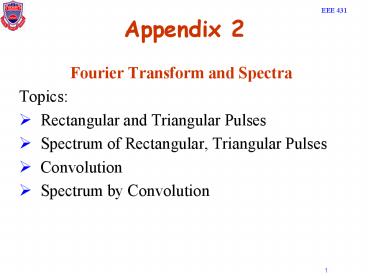Appendix 2 PowerPoint PPT Presentation
1 / 13
Title: Appendix 2
1
Appendix 2
- Fourier Transform and Spectra
- Topics
- Rectangular and Triangular Pulses
- Spectrum of Rectangular, Triangular Pulses
- Convolution
- Spectrum by Convolution
2
Rectangular Pulses
- The sinc(.) function is defined as
3
Triangular Pulses
4
Spectrum of a Rectangular Pulse
- Rectangular pulse is a time window.
- FT is a sinc function, infinite frequency
content. - Shrinking time axis causes stretching of
frequency axis. - Signals cannot be both time-limited and
bandwidth-limited.
Note the inverse relationship between the pulse
width T and the zero crossing 1/T
5
Spectrum of Sa Function
To find the spectrum of a Sa function we can use
duality theorem From Table 2.1 Duality W(t)
?? w(-f)
Because ? is an even and real function
graphically as
6
Spectrum of a Time Shifted Rectangular Pulse
- The spectra shown in previous slides are real
because the time domain pulse ( rectangular
pulse) is real and even. - If the pulse is offset in time domain to destroy
the even symmetry, the spectra will be complex. - Let us now apply the Time delay theorem of Table
2.1 to the Rectangular pulse.
Time Delay Theorem w(t-Td) ?? W(f) e-j?Td
We get
7
Spectrum of a Triangular Pulse
8
Spectrum of Rectangular and Sa Pulses
9
Table 2.2 Some FT pairs
10
Key FT Properties
- Time Scaling Contracting the time axis leads to
an expansion of the frequency axis. - Duality
- Symmetry between time and frequency domains.
- Reverse the pictures.
- Eliminates half the transform pairs.
- Frequency Shifting (Modulation) (multiplying a
time signal by an exponential) leads to a
frequency shift. - Multiplication in Time
- Becomes complicated convolution in frequency.
- Mod/Demod often involves multiplication.
- Time windowing becomes frequency convolution with
Sa. - Convolution in Time
- Becomes multiplication in frequency.
- Defines output of LTI filters easier to analyze
with FTs.
x(t)h(t)
x(t)
h(t)
11
Convolution
- The convolution of a waveform w1(t) with a
waveform w2(t) to produce a third waveform w3(t)
which is
where w1(t) w2(t) is a shorthand notation for
this integration operation and is read
convolved with. If discontinuous wave shapes
are to be convolved, it is usually easier to
evaluate the equivalent integral
- Evaluation of the integral involves 3 steps.
- Time reversal of w2 to obtain w2(-?),
- Time shifting of w2 by t seconds to obtain
w2(-(?-t)), and - Multiplying this result by w1 to form the
integrand w1(?)w2(-(?-t)).
12
Example for Convolution
For 0lt t lt T
For t gt T
13
Convolution
- y(t)x(t)z(t) ?x(t)z(t- t )d t
- Flip one signal and drag it across the other
- Area under product at drag offset t is y(t).
z(t)
x(t)
z(t-t)
x(t)
z(t)
t
t
t
t
t
t
t1
t-1
0
1
-1
0
1
-1
z(0-t)
z(2-t)
z(-6-t)
z(-2-t)
z(-4-t)
z(4-t)
t
2
0
1
-1
-6
-4
-2
y(t)
2
t
-4
0
1
-1
-2
-6

